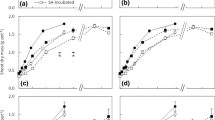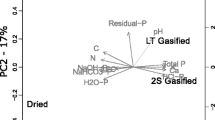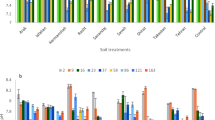Abstract
Phosphorus (P) inputs are required for sustainable agricultural production in most acid soils of the tropics and subtropics. Phosphate rocks (PR) and organic materials have been suggested as alternative P sources in these soils. Quantitative information on the P availability from sewage sludge (SL) is scanty. Methods to improve the effectiveness of PR such as partial acidulation and compaction with water-soluble P sources have been recommended. The objective of this greenhouse study was to evaluate the relative agronomic effectiveness (RAE) of Florida PR and sewage sludges (irradiated and non-irradiated) applied alone and in mixture with a water-soluble source (triple superphosphate, TSP) at two rates (50 and 150 mg P kg−1 soil). The 32P isotope dilution technique was utilised to determine the proportion of P in the plant taken up from the P fertilizer treatments. Wheat was grown on an acid loamy sand Dystric Eutrocrepts and harvested 6 weeks after planting. Results on total P uptake and the RAE of the P fertilizer sources tested indicated that the addition of 50 mg P kg−1 soil as TSP was adequate in supplying P to the 6-week-old wheat plants as compared to PR and sewage sludge. Intermediate values were obtained for the mixtures. Similar responses were observed for the high P rate. For a given P rate, phosphorus uptake from PR and SL in presence of TSP was higher than P uptake from these sources alone, indicating an enhancement effect of TSP on the effectiveness of these non-readily available sources. With respect to P uptake from PR applied alone, the relative increases in P uptake from PR due to TSP influence were 52 and 67% for the low and high P rates, respectively. The relative increases in P uptake from SL due to TSP when compared to P uptake from SL alone were 102 and 59% for the low and high P rates of application. Application of a water-soluble P fertilizer together with a non-readily available P source shows an enhancement on the P uptake from the non-readily available P source by the wheat plants. In this experiment the estimated enhancement effects are very likely underestimated.
Similar content being viewed by others
References
Chien SH & Friesen DK (1992) PR for direct application. In: Future Directions for Agricultural Phosphorus Research. TVA Bulletin Y-224, Muscle Shoals, AL, USA
Chien SH & Hammond LL (1988) Agronomic evaluation of partially acidulated phosphate rocks in the tropics: IFDC's experience. Paper Series IFDC-P7. International Fertilizer Development Center, Muscle Shoals, Alabama, USA
Chien SH & Menon RG (1995) Agronomic evaluation of modified phosphate rock products. IFDC's experience. Fertil Res 41: 197–209
Chien SH, Adams F, Khasawneh FE & Henao J (1987) Effects of combination of triple superphosphate and a reactive phosphate rock on yield and phosphorus uptake by corn. Soil Sci Soc Am J 51: 1656–1658
Chien SH, Menon RG & Billingham KS (1996) Estimation of phosphorus availability to maize and cowpea from phosphate rock as enhanced by water-soluble phosphorus. Soil Sci Soc Am J 60: 1173–1177
Frossard E, Sinaj S, Zhang LM & Morel JL (1996) The fate of sludge phosphorus in soil-plant systems. Soil Sci Soc Am J 60: 1248–1253
Gerzabek MH & Herger P (1997) Use of sewage sludge for plant nutrition. Final report. Austrian Research Centre Seibersdorf. OEFZS-A-4283. Seibersdorf, Austria, 14 p.
Gilkes RJ & Bolland MDA (1990) The Australian experience with rock phosphate: limitations and explanations. In: Phosphate Sources for Acid Soils in the Humid Tropics of Asia. Proc. of a Workshop, 6–7 December 1990. Kuala Lumpur, Malaysia
Hammond LL, Chien SH, Roy AH & Mokwunye AU (1986) Agronomic value of unacidulated and partially acidulated phosphate rocks indigenous to the tropics. Adv Agron 40: 89–140
Khasawneh FE & Doll EC (1978) The use of phosphate rocks for direct application. Adv Agron 30: 195–206
Kirkham MB (1982) Agricultural use of phosphorus in sewage sludges. Adv Agron 35: 129–163
Kitson RE & Mellon MG (1944) Colorimetric determination of phosphorus as molybdovanadophosphoric acid. Ind Eng Chem Anal Ed 16: 379–383
Kpomblekou K, Chien SH, Henao J & Hill WA (1991) Greenhouse evaluation of phosphate fertilisers produced from Togo phosphate rocks. Commun Soil Sci Plant Anal 22: 63–73
McLean EO & Wheeler RWC (1964) Partially acidulated rock phosphate as a source of phosphorus to plants. I. Growth chamber studies. Soil Sci Am Proc 28: 545–550
Mokwunye, AU & Chien, SH (1980) Reactions of partially acidulated phosphate rock with soils from the tropics. Soil Sci Soc Am J 44: 477–482
Remy JC & Orsini L (1976) Utilisation du chlorure de cobaltihexamine pour la détermination simultanée de la capacité d'échange et des bases échangeables de sols. Sci Sol 4: 161–175
SAS (1985) SAS Users Guide. Statistical Analysis System Institute Inc, Cary, NC, USA
Xiong LM, Zhou ZG & Lu RK (1996) Enhanced plant growth by uniform placement of superphosphate with rock phosphate in acidic soils. Commun Soil Sci Plant Anal 27(15–17): 2837–2850
Zapata F (1990) Isotope techniques in soil fertility and plant nutrition studies. In: Use of Nuclear Techniques in Studies of Soil-Plant Relationships (G. Hardarson, ed.). IAEA Training Manual Series No.2. IAEA, Vienna, Austria, pp. 61–127
Zapata F & Axmann H (1995) 32P isotopic techniques for evaluating the agronomic effectiveness of rock phosphate materials. Fertil Res 41: 189–195
Author information
Authors and Affiliations
Corresponding author
Rights and permissions
About this article
Cite this article
Zapata, F., Zaharah, A. Phosphorus availability from phosphate rock and sewage sludge as influenced by the addition of water soluble phosphate fertilizer. Nutrient Cycling in Agroecosystems 63, 43–48 (2002). https://doi.org/10.1023/A:1020518830129
Issue Date:
DOI: https://doi.org/10.1023/A:1020518830129




